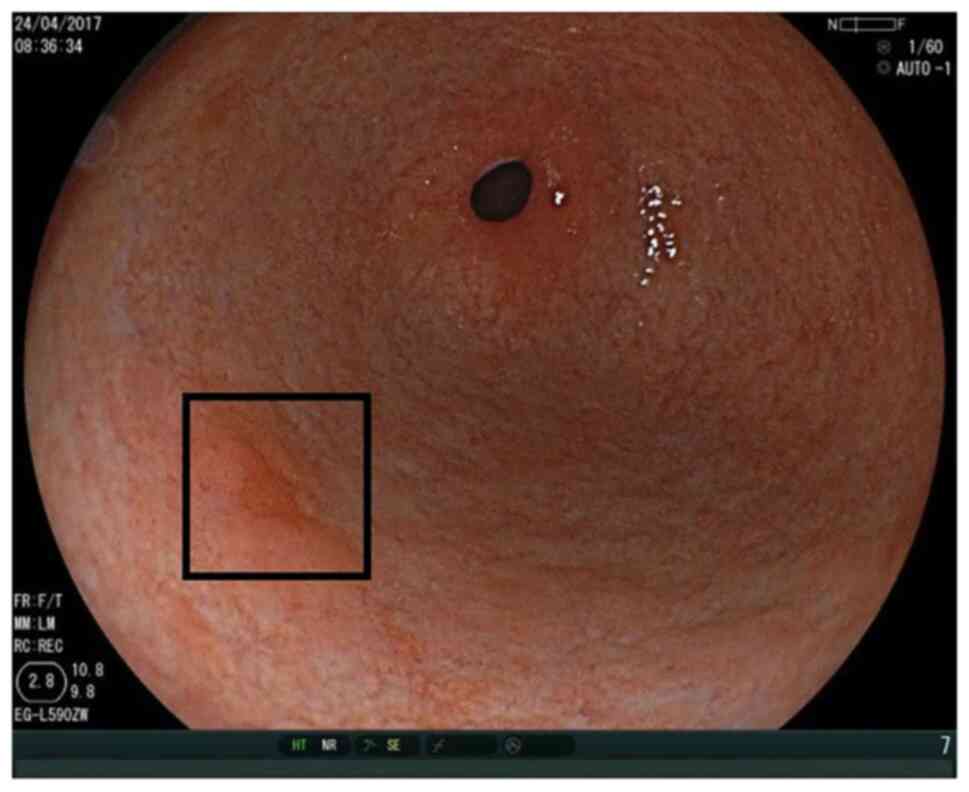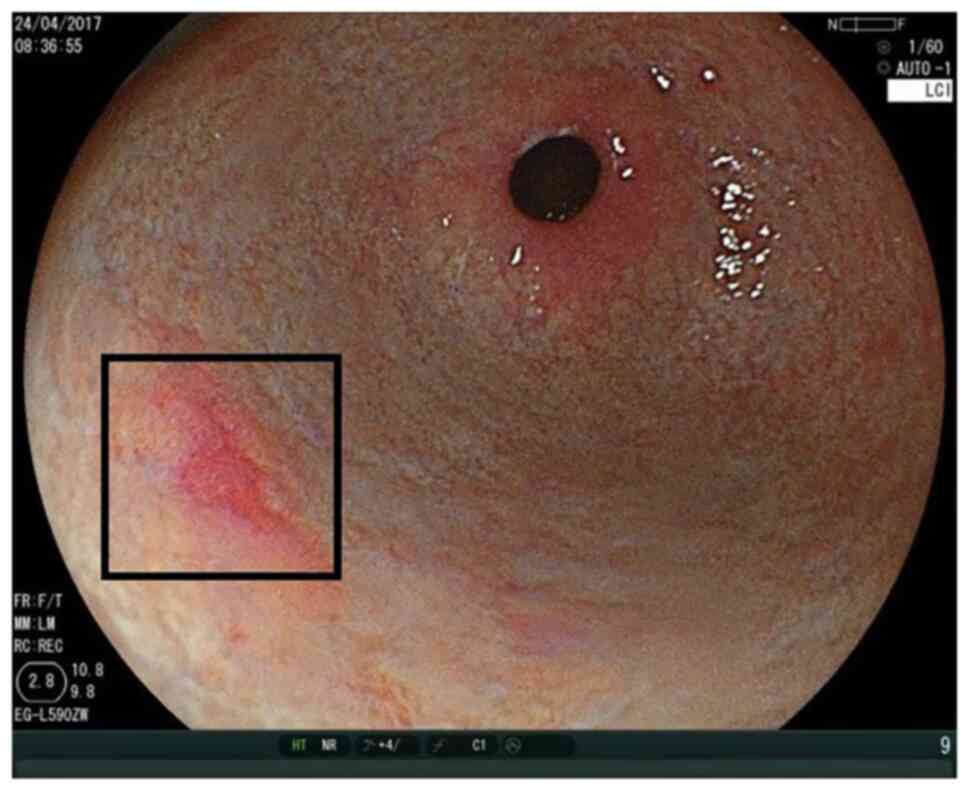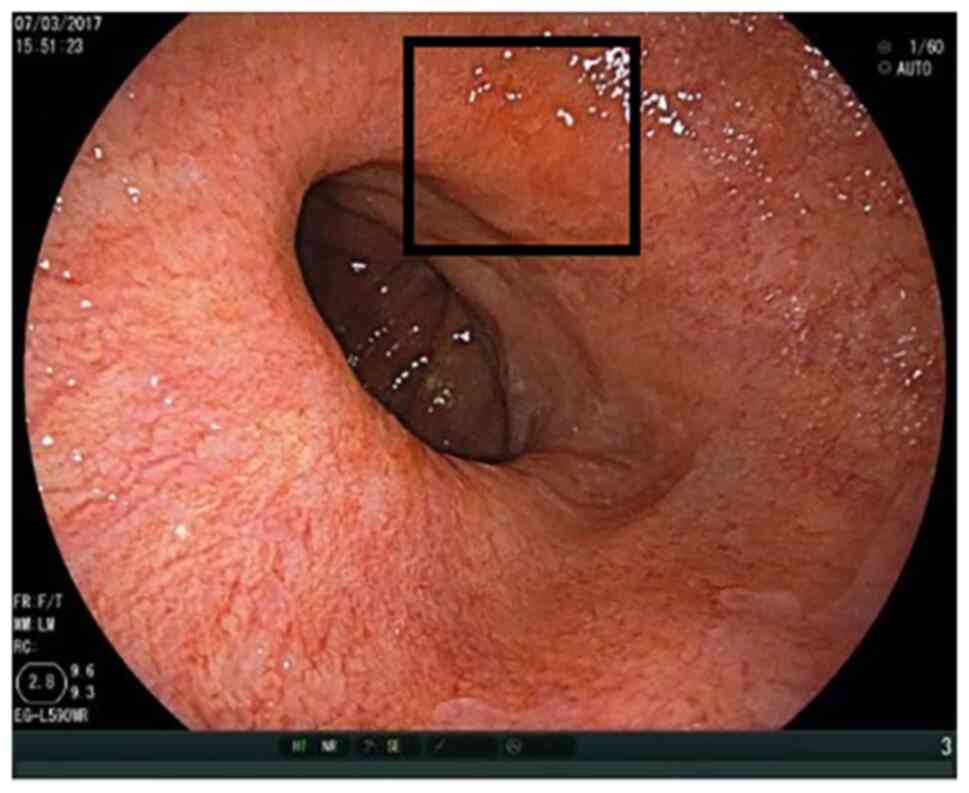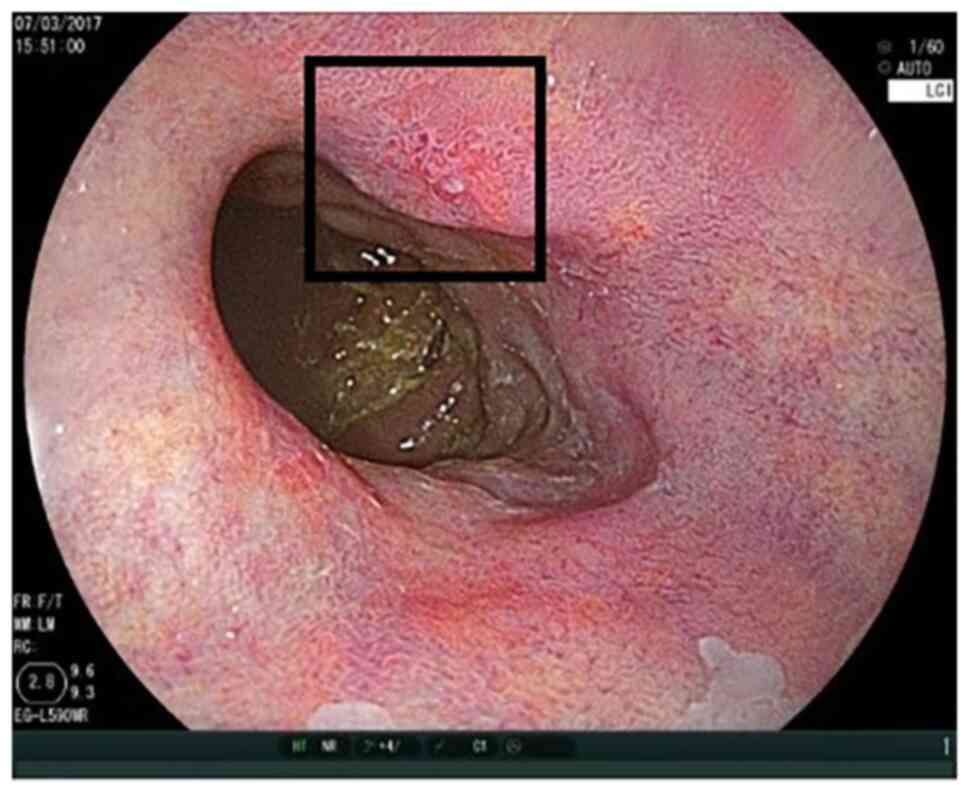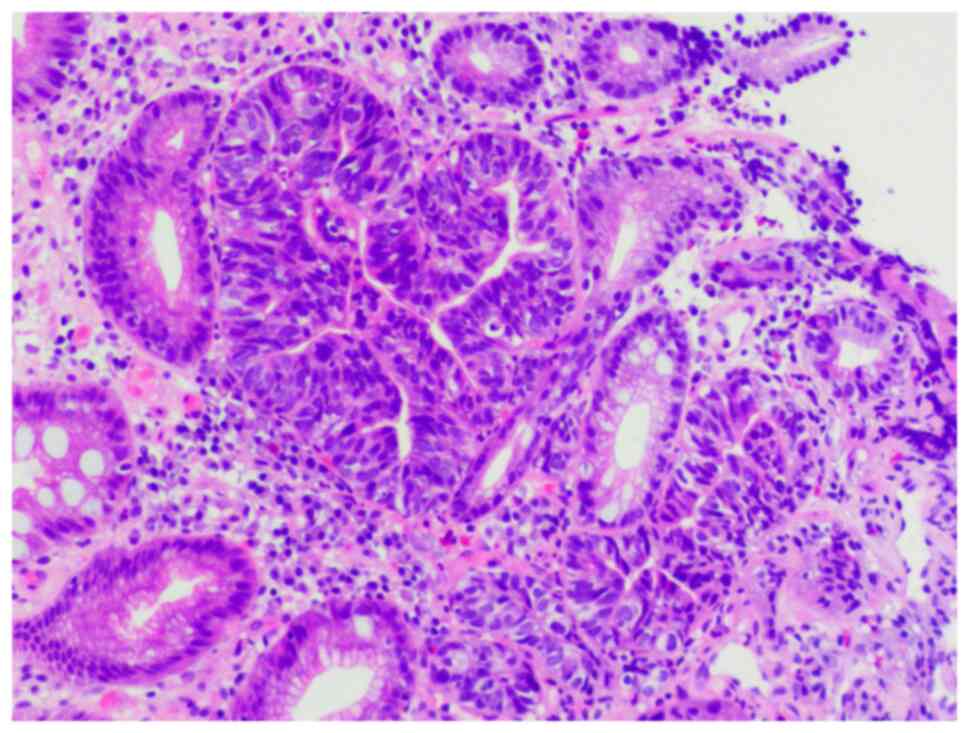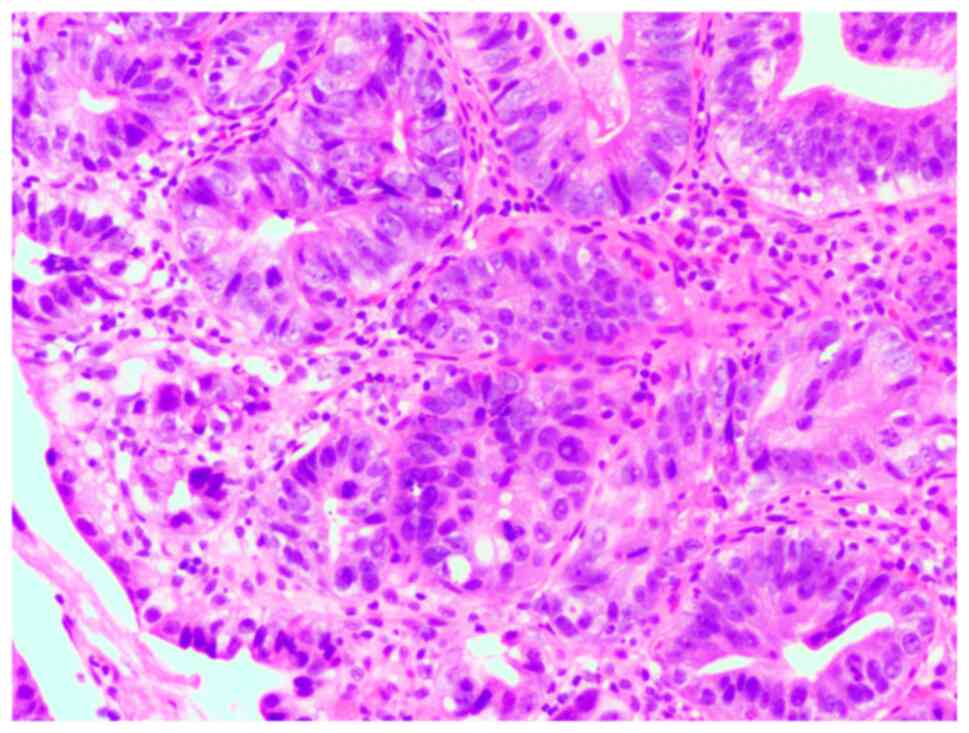Evaluation of the detection rate of high‑grade gastric intraepithelial neoplasia using linked color imaging and white light imaging
- Authors:
- Published online on: January 24, 2023 https://doi.org/10.3892/etm.2023.11806
- Article Number: 107
-
Copyright: © Lu et al. This is an open access article distributed under the terms of Creative Commons Attribution License.
Abstract
Introduction
Gastric cancer is a major cancer worldwide, with the fifth highest incidence and fourth highest mortality (1). Although endoscopy is the most sensitive diagnostic screening method, the detection of gastric cancer in the early stages is challenging (2,3). The effectiveness of gastric cancer treatment in developing countries is very low, and certain countries are unable to treat gastric cancer. However, the success rate of gastric cancer treatment in Japan is high (4,5). Japan mainly performs tumor resection for patients where gastric cancer has been detected early; the detection of cancer at an early stage is important for obtaining a good outcome. Early gastric cancer only shows mild morphological changes and color differences in relation to the surrounding mucosa (2,6). Due to these subtle manifestations, it can be challenging for junior endoscopists to diagnose, and numerous experts use white light imaging (WLI) to screen and diagnose patients with gastric cancer.
Several image-enhanced endoscopic (IEE) systems (7), including narrow-band imaging (NBI) (8,9), flexible spectral imaging color enhancement, blue laser imaging (BLI) and linked color imaging (LCI), have recently emerged as simple and convenient imaging methods for the detection of gastric tumours (10). Early gastric cancers may be missed by conventional endoscopy as they may not be easy to recognize (11). NBI and LCI are more intuitive than WLI regarding the visualization of epidermal vessels (12). LCI enhances the surface color and the boundary between the malignant lesion and the surrounding mucosa (12), with high diagnostic performance for gastrointestinal endoscopy (13). However, data on this subject are insufficient, with few papers reporting the diagnostic performance of LCI for high-grade gastric intraepithelial neoplasia. Therefore, the aim of the present study was to investigate whether LCI had improved diagnostic accuracy for high-grade gastric intraepithelial neoplasia compared with WLI, particularly when performed by junior endoscopists.
Materials and methods
Patients
From January 2017 to December 2017, 84 lesions from 81 patients diagnosed using LCI and WLI, and confirmed to have high-grade gastric intraepithelial neoplasia by the pathological examination of biopsy tissue, were enrolled in the present study. High-grade gastric intraepithelial neoplasia includes severe dysplasia and carcinoma in situ. Carcinoma in situ is distinguished from intramucosal carcinoma by the destruction of the basement membrane of the gland which occurs in the latter. Three patients who had two lesions were excluded and the remaining 78 patients who had only one lesion were included in the study. The lesions of macroscopic type are classified using the Paris classification (14-15): 0-IIa, slightly elevated; 0-IIb, flat; and 0-IIc, slightly depressed. The mean age of the patients was 46.44±11.99 years, and their sex ratio was 0.73:1 (male: female). The patients were enrolled at Shanxi Cancer Hospital (Taiyuan, China), and the study design was approved by the Ethics Committee of Shanxi Cancer Hospital (ref. no. 201992). Written informed consent was obtained from patients or their guardians for participation in the study. The inclusion criteria were as follows: Patients undergoing gastroscopy for the first time; diagnosed with high-grade gastric intraepithelial neoplasia by pathology after biopsy; and agreed to undergo detailed examination using the linkage imaging mode of the gastroscope (LASEREO EG L590ZW; Fujifilm Corporation). The exclusion criteria were as follows: Patients with incomplete clinical, endoscopic and pathological data; multiple gastric cancer lesions; and underwent radiotherapy or chemotherapy before the examination.
Endoscopic image acquisition and selection
The HD EG-L590WR endoscope (Fujifilm Corporation) was used for all examinations. Images of high-grade gastric intraepithelial neoplasia were captured carefully from the same place and angle as the unmagnified photographs with LCI and conventional WLI. Only endoscopic images of high-grade intraepithelial neoplasia were included; benign erosions, ulcers or polyps, which are also distinctive on WLI, were not examined. Figs. 1 and 2 show the ease of recognition of high-grade intraepithelial neoplasia by WLI as well as LCI. By contrast, Figs. 3 and 4 show that it can be challenging to recognise high-grade intraepithelial neoplasia by WLI, while recognition is easier using LCI. Two sets of images were collected for each patient, one acquired by WLI and the other by LCI. Next, both sets of images were numbered randomly. The images were captured by two expert endoscopists who had previously performed >5,000 esophagogastroduodenoscopies and did not participate in the subsequent study.
Pathological image acquisition
The fresh specimen was preserved by prompt immersion in a 10% neutral buffered formalin solution for fixation at room temperature for 24-48 h. The specimen was then dehydrated by immersion in 75% ethanol for 1 h, 85% ethanol for 1 h, 95% ethanol for 1 h twice and absolute ethanol for 1 h three times, then washed with xylene for 40 min twice and immersed in paraffin for 1 h four times. Wax embedding was subsequently performed by pouring molten wax into an embedding box, placing the specimens at the center of the bottom surface of the embedding box and injecting paraffin. The prepared embedding box was frozen at -20˚C for 1 h. Wax blocks were decanted from the embedding frame and sliced into 4-µm sections using a microtome.
To prepare the sections for hematoxylin and eosin staining, each specimen was promptly immersed in xylene for 5 min three times, then in 100, 95, 85 and 75% ethanol for 20 sec each, and finally in tap water for 20 sec. Subsequently, the specimen was immersed in hematoxylin solution for 5 min at room temperature and washed with water for 30 sec. It was then differentiated in 1% hydrochloric ethanol for 2 sec, rinsed with water for 30 sec and treated with lithium carbonate reverse blue solution for 1 min at room temperature. After this, it was immersed in 0.5% eosin ethanol solution for 1 min at room temperature, followed by 100% ethanol for 20 sec, 75, 85 and 95% ethanol for 10 sec each, 100% ethanol for 20 sec twice and xylene for 1 min three times. The stained specimens were finally sealed using a neutral gum sealing piece.
Pathological evaluation was performed by an experienced clinical pathologist using plain light microscopy. Figs. 5 and 6 show pathological images of high-grade gastric intraepithelial neoplasms that were easy and challenging, respectively, to recognize by imaging.
Methods of image analysis
Four senior endoscopists, each of whom had performed >5,000 esophagogastroduodenoscopies, and four junior endoscopists, each of whom had performed ~1,000 esophagogastroduodenoscopies, evaluated the images retrospectively. The patients were examined using conventional endoscopies with WLI and LCI under the same conditions. The sets of endoscopic images, divided into 156 groups, were presented to each endoscopist randomly. The study was designed only to evaluate the diagnosis of high-grade intraepithelial neoplasia; the location or size of the lesions was not considered. After the diagnoses were completed, the endoscopists immediately recorded the results as either positive or negative. The method of verification was through two sets of LCI and WLI image evaluation experiments conducted by different doctors.
Study outcomes
The primary outcome of this study was the rate of diagnosis between modalities and endoscopists. The secondary outcome was the interobserver agreement (16), which was calculated at 5 levels: 0.0-0.20=slight; 0.21-0.40=fair; 0.41-0.60=moderate; 0.61-0.80=substantial; and 0.81-1.00=almost perfect.
Statistical analysis
Quantitative data are expressed as the mean and standard deviation. The rates of diagnosis between modalities and endoscopists were compared using the χ2 test. P<0.05 was considered to indicate a statistically significant result. The interobserver agreement was evaluated using Kappa test. All statistical analysis was performed using SPSS 19.0 statistical software (IBM Corp.).
Results
Baseline characteristics
From January 2017 to December 2017, 78 patients were enrolled in the study. The patients were confirmed to have high-grade gastric intraepithelial neoplasia by pathological examination of the biopsy tissues. The mean age of the patients was 46.44±11.99 years and their sex ratio was 0.73:1 (male:female). Table I displays characteristics of the patients and their tumors.
Evaluation of the WLI images
Table II reports the results of the evaluation of the WLI images by the eight endoscopists. The lesion detection rates by the four junior endoscopists were 30/78 (38.46%), 32/78 (41.03%), 35/78 (44.87) and 31/78 (39.74). There were no significant differences among the four junior endoscopists in their evaluation of the WLI images. The lesion detection rates by the four senior endoscopists were 47/78 (60.26%), 45/78 (57.69%), 45/78 (57.69%) and 50/78 (64.10%). There were also no significant differences in detection rates among the four senior endoscopists.
Evaluation of the LCI images
Table III reports the results of the evaluation of the LCI images by the eight endoscopists. The lesion detection rates by the four junior endoscopists were 64/78 (82.05%), 66/78 (84.62%), 69/78 (88.46%) and 67/78 (85.90%), respectively. No significant differences were identified among the four junior endoscopists in the evaluation of the images. The lesion detection rates by the four senior endoscopists were 70/78 (89.74%), 70/78 (89.74%), 68/78 (87.18%) and 71/78 (91.03%), respectively. No significant differences in detection rates were detected among the four senior endoscopists.
Detection rates
Table IV reports the detection rates obtained using WLI and LCI for the junior and senior endoscopists. The lesion detection rates by the junior and senior endoscopists based on images obtained by WLI were 128/312 (41.03%) and 187/312 (59.94%), respectively. The lesion detection rates of the junior and senior endoscopists were significantly different. The lesion detection rates by the junior and senior endoscopists based on images obtained by LCI were 266/312 (85.26%) and 279/312 (89.42%), respectively. The lesion detection rates of the junior and senior endoscopists were not significantly different.
Interobserver agreement values
Table V reports that the interobserver agreement values for WLI and LCI were 0.54 and 0.59 for junior endoscopists and 0.63 and 0.65 for senior endoscopists, respectively. These values indicate that the interobserver agreement was good to satisfactory.
Discussion
Gastric cancer is a malignant disease that is challenging to treat (17). Following years of research, a consensus on the utility of endoscopy for gastric cancer diagnosis has been reached, along with recommendations to reduce Helicobacter pylori infections, take sufficient exercise and follow a healthy lifestyle (18). The early detection of gastric cancer increases the likelihood of treatments being effective (19-21).
For the early diagnosis of gastric cancer, the timely detection of early lesions is very important. Characteristics of lesions revealed by IEE techniques are enhancement and a change in color. Observation using image-enhanced endoscopy enables the early signs of gastric cancer to be detected effectively. LCI aids visualization of the difference between gastric lesions and normal stomach tissue and enables junior endoscopists to observe the difference between the two types of tissue (22).
The present study is a comparative analysis of the diagnostic utility of LCI for high-grade gastric intraepithelial neoplasia. Gastric lesions and normal stomach tissue may be distinguished when observed using LCI due to a difference in color. Color differences observed by LCI are more obvious than those observed by WLI. Improved detection rates were observed for junior and senior endoscopists using LCI compared with WLI, and the difference in detection rates was statistically significant. These results indicate that in the early diagnosis of gastric cancer, LCI is more effective than WLI.
With WLI, the lesion detection rate for junior endoscopists ranged from 38.46 to 44.87%, and for senior endoscopists, it ranged from 57.69 to 64.10%. These results suggest that senior endoscopists had a much higher detection rate than junior endoscopists, and the lesion detection rate using WLI was significantly different between junior and senior endoscopists. By contrast, the detection rate using LCI improved to >80% for both senior and junior endoscopists, and no significant differences were detected between them. The results of the present study indicate that LCI allows the easy recognition and early detection of gastric cancer even by junior endoscopists, which may improve the rate of diagnosis and reduce that of misdiagnosis, regardless of the level of experience of the endoscopist. LCI may enable the gap in the detection rate of high-grade gastric intraepithelial neoplasia between junior and senior endoscopists to be narrowed.
Yoshifuku et al (23) evaluated the visibility of early gastric cancer using LCI and BLI. The study found that LCI improved the visibility of early gastric cancer, regardless of the endoscopist's experience or Helicobacter pylori eradication in patients, compared with BLI; the visibility obtained with LCI was significantly higher with than that obtained with BLI. In another study, Suzuki et al (24) reported the efficacy of LCI in improving the visibility of flat colorectal lesions compared with BLI. When compared with WLI and BLI, LCI presents greater color differences between gastric lesions and the mucosa around the stomach, thereby improving the detection of gastric cancer, as verified by the current study and previous research.
The present study has some limitations. First, a relatively small patient sample was examined rather than a large-scale cohort and type 0-IIb lesions were not included. Therefore, the effectiveness of LCI for the detection of 0-IIb lesions remains unclear. To address this, random evaluations and controlled multicenter clinical trials are required. Secondly, only endoscopic images of high-grade intraepithelial neoplasia were examined, as they were the focus of the study. Benign erosions, ulcers and polyps, which are also distinctive when viewed using WLI, were not examined. Therefore, other reddish lesions require further examination in future studies.
In conclusion, the present study shows that junior endoscopists can detect gastric cancer early using LCI, which may improve the rate of diagnosis and reduce misdiagnosis, regardless of the level of experience of the endoscopist. Additionally, the use of LCI may narrow the gap in detection rates between junior and senior endoscopists for high-grade gastric intraepithelial neoplasia.
Acknowledgements
The authors would like to thank Dr Qi Zhao (Shanxi Cancer Hospital, Department of Pathology) for their theoretical guidance on pathology.
Funding
Funding: The study was funded by Key Research and Development Projects of Shanxi Province (grant no. 201903D321140).
Availability of data and materials
The datasets used and/or analyzed during the current study are available from the corresponding author on reasonable request.
Authors' contributions
XC conceived and supervised the study. JHL and HHC designed the study. HHC, JHL and HZZ performed data collection and processing. HZZ, WBZ and JF analyzed and interpreted the data. JHL and WBZ conducted the literature search. JHL and HHC wrote the manuscript. XC critically reviewed the manuscript. All authors read and approved the final version of the manuscript. XC and JHL confirm the authenticity of all the raw data.
Ethics approval and consent to participate
Ethics committee approval was provided for this study by the Ethics Committee of Shanxi Cancer Hospital (approval. no. 201992). Written informed consent was obtained from patients or their guardians for participation in the study.
Patient consent for publication
Not applicable.
Authors' information
Junhui Lu is a PhD student, ORCID no. 0000-0003-2387-5945; Haihua Chen is a Bachelor of Medicine, ORCID no. 0000-0002-1581-0490; Xing Chen is a Doctor of Medicine, ORCID no. 0000-0003-3806-5494; Hezhao Zhang is a PhD student, ORCID no. 0000-0002-9565-4298; Jing Fan is a Master of Medicine, ORCID no. 0000-0002-7080-0666; and Wenbin Zhang is a Master of Medicine, ORCID no. 0000-0003-1995-6750.
Competing interests
The authors declare that they have no competing interests.
References
|
Sung H, Ferlay J, Siegel RL, Laversanne M, Soerjomataram I, Jemal A and Bray F: Global cancer statistics 2020: GLOBOCAN estimates of incidence and mortality worldwide for 36 cancers in 185 countries. CA Cancer J Clin. 71:209–249. 2021.PubMed/NCBI View Article : Google Scholar | |
|
Yao K, Uedo N, Kamada T, Hirasawa T, Nagahama T, Yoshinaga S, Oka M, Inoue K, Mabe K, Yao T, et al: Guidelines for endoscopic diagnosis of early gastric cancer. Dig Endosc. 32:663–698. 2020.PubMed/NCBI View Article : Google Scholar | |
|
Parkin DM, Bray F, Ferlay J and Pisani P: Global cancer statistics, 2002. CA Cancer J Clin. 55:74–108. 2005.PubMed/NCBI View Article : Google Scholar | |
|
Tanabe S, Hirabayashi S, Oda I, Ono H, Nashimoto A, Isobe Y, Miyashiro I, Tsujitani S, Seto Y, Fukagawa T, et al: Gastric cancer treated by endoscopic submucosal dissection or endoscopic mucosal resection in Japan from 2004 through 2006: JGCA nationwide registry conducted in 2013. Gastric Cancer. 20:834–842. 2017.PubMed/NCBI View Article : Google Scholar | |
|
Young E, Philpott H and Singh R: Endoscopic diagnosis and treatment of gastric dysplasia and early cancer: Current evidence and what the future may hold. World J Gastroenterol. 27:5126–5151. 2021.PubMed/NCBI View Article : Google Scholar | |
|
Nasu J, Doi T, Endo H, Nishina T, Hirasaki S and Hyodo I: Characteristics of metachronous multiple early gastric cancers after endoscopic mucosal resection. Endoscopy. 37:990–993. 2005.PubMed/NCBI View Article : Google Scholar | |
|
Loncroft-Wheaton G and Bhandari P: Image enhanced endoscopy: Optical diagnosis or optical illusion? Saudi J Gastroenterol. 25:71–72. 2019.PubMed/NCBI View Article : Google Scholar | |
|
Doyama H, Nakanishi H and Yao K: Image-enhanced endoscopy and its corresponding histopathology in the stomach. Gut Liver. 15:329–337. 2021.PubMed/NCBI View Article : Google Scholar | |
|
Yoshida N, Doyama H, Yano T, Horimatsu T, Uedo N, Yamamoto Y, Kakushima N, Kanzaki H, Hori S, Yao K, et al: Early gastric cancer detection in high-risk patients: A multicentre randomised controlled trial on the effect of second-generation narrow band imaging. Gut. 70:67–75. 2021.PubMed/NCBI View Article : Google Scholar | |
|
Zhenming Y and Lei S: Diagnostic value of blue laser imaging combined with magnifying endoscopy for precancerous and early gastric cancer lesions. Turk J Gastroenterol. 30:549–556. 2019.PubMed/NCBI View Article : Google Scholar | |
|
Onozato Y, Ishihara H, Iizuka H, Sohara N, Kakizaki S, Okamura S and Mori M: Endoscopic submucosal dissection for early gastric cancers and large flat adenomas. Endoscopy. 38:980–986. 2006.PubMed/NCBI View Article : Google Scholar | |
|
Fujimoto D, Muguruma N, Okamoto K, Fujino Y, Kagemoto K, Okada Y, Takaoka Y, Mitsui Y, Kitamura S, Kimura T, et al: Linked color imaging enhances endoscopic detection of sessile serrated adenoma/polyps. Endosc Int Open. 6:E322–E334. 2018.PubMed/NCBI View Article : Google Scholar | |
|
Ono S, Abiko S and Kato M: Linked color imaging enhances gastric cancer in gastric intestinal metaplasia. Dig Endosc. 29:230–231. 2017.PubMed/NCBI View Article : Google Scholar | |
|
The Paris endoscopic classification of superficial neoplastic lesions: Esophagus, stomach, and colon: November 30 to December 1, 2002. Gastrointest Endosc. 58 (6 Suppl):S3–S43. 2003.PubMed/NCBI View Article : Google Scholar | |
|
Endoscopic Classification Review Group. Update on the paris classification of superficial neoplastic lesions in the digestive tract. Endoscopy. 37:570–578. 2005.PubMed/NCBI View Article : Google Scholar | |
|
Landis JR and Koch GG: The measurement of observer agreement for categorical data. Biometrics. 33:159–174. 1977.PubMed/NCBI | |
|
Toyokawa T, Inaba T, Omote S, Okamoto A, Miyasaka R, Watanabe K, Izumikawa K, Fujita I, Horii J, Ishikawa S, et al: Risk factors for non-curative resection of early gastric neoplasms with endoscopic submucosal dissection: Analysis of 1,123 lesions. Exp Ther Med. 9:1209–1214. 2015.PubMed/NCBI View Article : Google Scholar | |
|
Nakanishi H, Doyama H, Ishikawa H, Uedo N, Gotoda T, Kato M, Nagao S, Nagami Y, Aoyagi H, Imagawa A, et al: Evaluation of an e-learning system for diagnosis of gastric lesions using magnifying narrow-band imaging: A multicenter randomized controlled study. Endoscopy. 49:957–967. 2017.PubMed/NCBI View Article : Google Scholar | |
|
Fujiyoshi MRA, Inoue H, Fujiyoshi Y, Nishikawa Y, Toshimori A, Shimamura Y, Tanabe M, Ikeda H and Onimaru M: Endoscopic classifications of early gastric cancer: A literature review. Cancers (Basel). 14(100)2021.PubMed/NCBI View Article : Google Scholar | |
|
Park JH, Lee KN, Lee HL, Jun DW, Yoon JH, Lee OY, Yoon BC and Choi HS: Rates and risk factors for interval gastric cancers at screening gastroscopy. Turk J Gastroenterol. 32:194–202. 2021.PubMed/NCBI View Article : Google Scholar | |
|
Chen MJ, Wu W, Pan S, Lin CJ, Dong LM, Chen ZF, Wu JS and Huang ZM: Sedated gastroscopy improves detection of gastric polyps. Exp Ther Med. 16:3116–3120. 2018.PubMed/NCBI View Article : Google Scholar | |
|
Zhu Y, Wang F, Zhou Y, Xia GL, Dong L, He WH and Xiao B: Blue laser magnifying endoscopy in the diagnosis of chronic gastritis. Exp Ther Med. 18:1993–2000. 2019.PubMed/NCBI View Article : Google Scholar | |
|
Yoshifuku Y, Sanomura Y, Oka S, Kurihara M, Mizumoto T, Miwata T, Urabe Y, Hiyama T, Tanaka S and Chayama K: Evaluation of the visibility of early gastric cancer using linked color imaging and blue laser imaging. BMC Gastroenterol. 17(150)2017.PubMed/NCBI View Article : Google Scholar | |
|
Suzuki T, Hara T, Kitagawa Y, Takashiro H, Nankinzan R, Sugita O and Yamaguchi T: Linked-color imaging improves endoscopic visibility of colorectal nongranular flat lesions. Gastrointest Endosc. 86:692–697. 2017.PubMed/NCBI View Article : Google Scholar |



